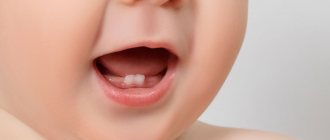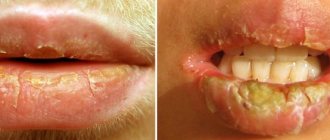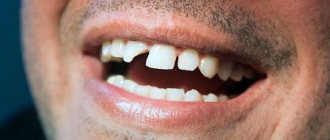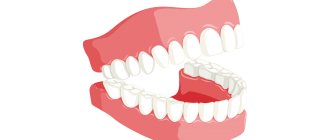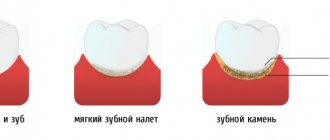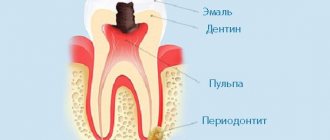10% discount on veneers and crowns
Moscow
Caries, bleeding, chips are the main, but not the only problems that can arise in the oral cavity. In some cases, small cracks may appear on the teeth, which are discovered during a routine dental appointment. If the crack becomes deeper, then it can be seen with the naked eye. At the same time, such a defect does not affect the stability and integrity of the tooth, and therefore many believe that it does not require treatment. This opinion is wrong. After all, the bone tissue of the tooth will gradually deteriorate, which will lead to disastrous consequences. Don't want to let this happen? Then immediately contact your dentist if you notice thin, uncharacteristic stripes on your teeth, or if sensitivity increases for no apparent reason.
Symptoms of a cracked tooth
A tooth crack is a split in the enamel, which causes the main symptoms:
- Increased sensitivity to hot and cold.
- Aching pain for no apparent reason.
- Unpleasant sensations when closing the jaw.
It is important to understand that small cracks may not be noticeable, but over time they increase, and the tooth itself is destroyed. In order to prevent destruction, it is better to seek help in a timely manner if you discover one or another sign of a condition deviating from the norm. After all, in this case, treatment will be faster and will cost you less.
Types of cracks: classification
Depending on where the crack occurs, in dentistry there is a different classification of this pathology, and appropriate treatment is also prescribed. Thus, destruction can affect enamel and denta. If a small strip appears, it will be enough to restore the tooth, but if it is more significant, it will be necessary to install a veneer. If the layers of the denta are affected, then in some cases you can even lose a tooth.
As a rule, destruction begins with a small crack, which increases in length, expands, or forms a network. According to statistics, such destruction often appears in the lower jaw, which bears heavy loads. Moreover, treated carious teeth can more often form pathology. After all, they are more weakened.
The problem can occur both on the front and back walls of the tooth, and can also form between the teeth, which over time will lead to hidden caries. After all, it is very difficult to detect such a defect.
With deep destruction, black cracks form, which can be noticed independently. Depending on the location, the pathology can be oblique, horizontal and vertical.
Vertical
A vertical streak most often occurs on the front tooth. It can go along the entire surface, affecting the root. If the pulp is affected, the tooth will have to be removed. So, if you find a longitudinal stripe, you should immediately contact your dentist so that the treatment is quick and painless.
Horizontal
Horizontal cracks are considered the most dangerous, since their enlargement often leads to tooth loss as a result of its fracture. At the same time, dental practice shows that with such pathology the process of destruction proceeds more slowly and pulpitis does not occur.
Oblique
Like horizontal cracks, inclined cracks damage the pulp, and therefore such a tooth cannot be restored - it must be removed. Since the defect can begin with a small vertical destruction, you should not start the process by contacting a specialist.
Is it possible to reverse tooth decay?
If you have already noticed the first stages of enamel destruction, then caries cannot be reversed, but it can be slowed down, stretching the process over decades. Ion exchange reactions always occur on the surface of the enamel, allowing one to maintain a delicate balance between demineralization (destruction) and remineralization (restoration) of the enamel. Calcium and magnesium ions, phosphate ions, carbonate ions, strontium and fluorine ions can penetrate into the hydroxyapatite crystal. Of all the listed ions, we are especially interested in the fluorine ion F⁻ . Fluorine can replace the hydroxyl group (OH⁻) of enamel hydroxyapatite, forming fluorapatite Ca₅(PO₄)₃F . Fluorapatite is more resistant to acids, so the vital activity of bacteria has little effect on it [6].
In the article “Tooth Strength: How Do Pastes Make Our Teeth Better?” [10] of the special project “Biology, Medicine and Cosmetology of the Oral Cavity” talks in detail about fluoride and other useful components of toothpastes. - Ed.
Fluoride therapy is used to prevent tooth decay. The most pronounced effect is observed with optimal intake of fluoride ions into the body during the development of primary and molar teeth, that is, in childhood, but also in the first stages of caries - in the white spot stage - such therapy can slow down its course [6], [8] . Eating a balanced diet will also help keep tooth decay at bay. Cereals (bran, whole grain flour, sprouted grains), vegetables and fruits, spices (parsley, cumin, spinach), as well as animal products (fish, meat, especially bone broth, liver, seafood) contain large amounts of fluoride.
Well, if caries is already noticeable with might and main, then radical measures will be required to eliminate it in the dentist’s chair. By the way, the filling material also contains fluorapatite.
Take care of your teeth!
This short review article has already been published by the author here: https://vk.com/@biovk-temnye-delishki-nashih-zubov-karies.
Causes of cracks
Why do cracks appear? The main reason is mechanical damage and daily stress on the teeth. Moreover, the general condition of the human body should also be taken into account. After all, one person may have such strong teeth that even daily crunching of nuts does not threaten to break the tooth, while for others, excessively hard food becomes their worst enemy. The reason for this is the characteristics of bone tissue.
Moreover, you should not think that you can avoid cracks by giving up solid food. After all, we must not forget that during the chewing process, the gums are massaged, which improves the condition of the oral cavity. It’s just important to observe moderation in everything if you want to have healthy teeth.
In addition to daily stress, the cause of crack formation can be:
- Bruises, falls, other jaw injuries.
- Opening bottles and cracking nuts with teeth.
- Bad habits of chewing pencils or other objects.
- Bruxism.
- Bite disorders.
It should be understood that smoking, lack of proper oral hygiene, and abuse of coloring foods and drinks are also potential threats.
10% discount on veneers and crowns
Moscow
How to treat cracked teeth?
Any treatment begins with a visit to the dentist, who will examine the oral cavity. After this, you may be referred for an x-ray. After all, it is possible to quickly detect a defect only if it is located on the front tooth. If the patient has typical complaints, it will be possible to notice the crack only with the help of an image. In addition, professional teeth cleaning may be required, which will make it possible to fully assess the condition of the oral cavity and detect the slightest defects in the tooth enamel.
You need to understand that you won’t be able to remove cracks on your own. And delaying a visit to the doctor can only worsen the pathology. Therefore, it is better to immediately contact a specialist who will select the appropriate type of treatment:
- Remineralization.
Using a dental gel with calcium, phosphorus and fluorine, the enamel is restored. Next, the crack is filled with a composite, which hardens under the influence of a special lamp. Next, the tooth is treated with dental varnish, which acts as additional protection. - Veneers.
Thin plates are installed on the tooth, which protect it from destruction and mechanical damage. Veneers are individually made for each patient, which ensures maximum adherence to the tooth. You can use the veneer installation service in our clinic. - Crown.
If a partial tooth extraction is performed due to a crack, your dentist may suggest a crown to save the remaining portion of the tooth. In this case, the nerve will be removed and root canals will be performed. After this, the dental crown will be placed. - Delete.
If the tooth cannot be restored, it will need to be removed. An implant can be placed in place of the extracted tooth.
Professional Air Flow cleaning
This method is considered the most gentle on enamel and painless. The essence of the procedure is to influence deposits with a mixture of water, air and soda crystals, which is supplied under pressure. This way you can clean your teeth and the spaces between them.
The dentist recommends Air Flow cleaning to the patient in the following cases:
- the presence of plaque that turns into stone;
- discoloration of enamel caused by drinking strong tea, coffee, carbonated drinks, smoking;
- if it is necessary to install or remove crowns, braces, implants, high-quality cleaning of these systems;
- the presence of tightly spaced, twisted teeth in a row;
- the appearance of symptoms of periodontal disease.
Timely cleaning with such a device helps prevent the development of caries, gingivitis, periodontitis and periodontal disease. It allows you to effectively remove deposits on teeth, between units, even in the most inaccessible places, as well as on dental structures. At the same time, the enamel becomes lighter by 1-2 tones, pigment spots disappear. During polishing, the enamel is saturated with fluoride and strengthened.
Despite all the advantages of Air Flow, this procedure has a number of contraindications. In particular, it is not carried out when:
- severe pathologies of the respiratory system, including bronchial asthma;
- hepatitis;
- diabetes mellitus;
- tuberculosis;
- tendency to allergic reactions;
- HIV;
- infectious diseases;
- heart rhythm disturbances, presence of a pacemaker;
- increased sensitivity of enamel;
- the presence of areas of demineralization;
- installed titanium implants.
This method of professional cleaning is not recommended during pregnancy and lactation.
After the procedure, for 2-3 days the patient may complain of pain when eating cold and hot food. To reduce enamel sensitivity, you must use toothpaste labeled “Sensitive.” Be sure to buy a new brush with soft bristles.
During this period, it is better to exclude sour and sweet foods, cold and hot foods from the diet, refuse to drink carbonated drinks with dyes (including low-alcohol ones), coffee, strong black tea, and red wine. It is undesirable to eat red and orange fruits and vegetables.
Prevention of tooth decay
How can you avoid a cracked tooth? No one will give a 100% guarantee here. After all, any pathology can arise individually. However, it is possible to minimize the risks if you follow these recommendations:
- Monitor oral hygiene.
- After consuming coloring foods and drinks, rinse your mouth.
- Avoid harsh mechanical impacts on teeth (do not crack nuts, do not open bottles).
- Use dental floss, as well as toothpastes containing calcium.
- Do not use whitening toothpastes more than 7 days a month.
- Do not eat very hot and very cold foods at the same time.
- Stop smoking.
- Review your diet to include foods containing calcium.
- Visit the dentist's office regularly.
Remember that 90% of the health of your teeth depends on your careful attitude towards them. And timely consultation with a doctor allows you to avoid unpleasant consequences. At our clinic, you can undergo preventive procedures that will keep your smile flawless.
Why do teeth turn black?
If a tooth near the gum turns black, carefully examine the remaining teeth - because most likely, it is not alone. Typically, black plaque affects all the teeth in a certain area. This may be due to the following reasons:
- Drinking coloring drinks (tea, coffee, cola) and smoking.
- Insufficient oral hygiene.
- Parasitic infections.
- Dysbacteriosis of the intestines and oral cavity (this is a typical cause of the appearance of black plaque on the teeth of children).
- Long-term use of certain medications.
- Immunodeficiency and metabolic diseases.
These and some other reasons can cause darkening of the enamel of all teeth or black plaque that literally sticks to the teeth and does not respond to a toothbrush, dental floss and other methods of cleaning teeth at home.
If you have a problem similar to that described in this article, be sure to contact our specialists. Don't diagnose yourself!
Why you should call us now:
- We will answer all your questions in 3 minutes
- Free consultation
- The average work experience of doctors is 12 years
- Convenient location of clinics
Single contact phone number: +7
Make an appointment
Cracks in teeth: photo
Author: Alexander Yaganov Dentist-orthodontist. Work experience more than 7 years. The information is for reference only. Before treatment, consultation with a doctor is necessary.

